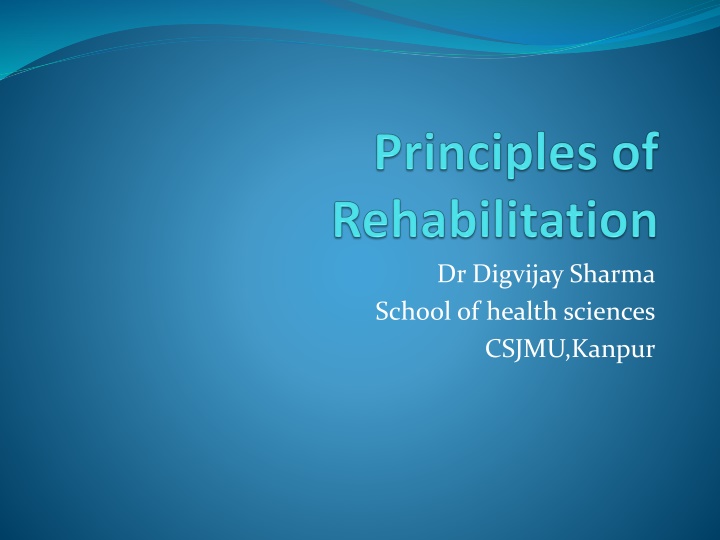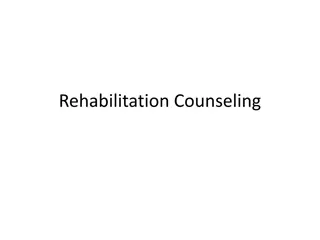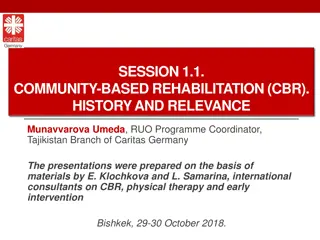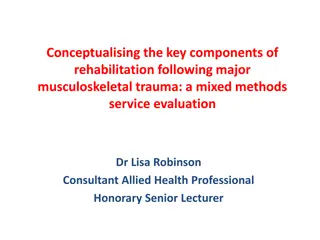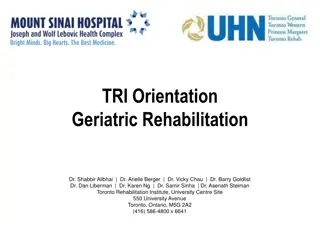Principles of Rehabilitation in Healthcare
Rehabilitation is centered on empowering individuals to take charge of their health, recognizing their inherent worth as unique entities. Understanding and implementing the seven principles of rehabilitation - Avoid aggravation, Timing, Compliance, Individualization, Specific sequencing, Intensity, and Total patient - are crucial for successful rehabilitation outcomes. Emphasizing factors like avoiding aggravation, starting timely exercises, ensuring patient compliance, and individualizing care based on patient response are key components in rehabilitation processes.
Download Presentation

Please find below an Image/Link to download the presentation.
The content on the website is provided AS IS for your information and personal use only. It may not be sold, licensed, or shared on other websites without obtaining consent from the author.If you encounter any issues during the download, it is possible that the publisher has removed the file from their server.
You are allowed to download the files provided on this website for personal or commercial use, subject to the condition that they are used lawfully. All files are the property of their respective owners.
The content on the website is provided AS IS for your information and personal use only. It may not be sold, licensed, or shared on other websites without obtaining consent from the author.
E N D
Presentation Transcript
Dr Digvijay Sharma School of health sciences CSJMU,Kanpur
Rehabilitation Rehabilitation is founded on the philosophy that every person has the right to be in charge of their health and that they also have inherent worth. This philosophy results in the viewpoint of every individual as being a comprehensive, holistic and unique entity.
Principles of Rehabilitation Principles direct the discharge of rehabilitation care. These principles guide the rehabilitation professional in developing the plan of care for the individual undergoing rehabilitation. Rehabilitation principles need to be understood by all rehabilitation team members to obtain desirable outcomes in the process of rehabilitation.
Principles of Rehabilitation There are seven principles of rehabilitation: Avoid aggravation Timing Compliance Individualization Specific sequencing Intensity Total patient
Avoid aggravation It is important not to aggravate the injury during the rehabilitation process. Therapeutic exercise, if administered incorrectly or without good judgment, has the potential to exacerbate the injury, that is, make it worse. The primary concern of the therapeutic exercise program is to advance the injured individual gradually and steadily and to keep setbacks to a minimum.
Timing The therapeutic exercise portion of the rehabilitation program should begin as soon as possible that is, as soon as it can occur without causing aggravation. The sooner patients can begin the exercise portion of the rehabilitation program, the sooner they can return to full activity. Following injury, rest is sometimes necessary, but too much rest can actually be detrimental to recovery.
Compliance Without a compliant patient, the rehabilitation program will not be successful. To ensure compliance, it is important to inform the patient of the content of the program and the expected course of rehabilitation. Patients are more compliant when they are better aware of the program they will be following, the work they will have to do, and the components of the rehabilitation process.
Individualization Each person responds differently to an injury and to the subsequent rehabilitation program. Expecting a patient to progress in the same way as the last patient you had with a similar injury will be frustrating for both you and the patient. It is first necessary to recognize that each person is different. It is also important to realize that even though an injury may seem the same in type and severity as another, undetectable differences can change an individual's response to it. Individual physiological and chemical differences profoundly affect a patient's specific responses to an injury.
Specific sequencing A therapeutic exercise program should follow a specific sequence of events. This specific sequence is determined by the body's physiological healing response and is briefly addressed in the next section of this chapter
Intensity The intensity level of the therapeutic exercise program must challenge the patient and the injured area but at the same time must not cause aggravation. Knowing when to increase intensity without overtaxing the injury requires observation of the patient's response and consideration of the healing process.
Total patient You must consider the total patient in the rehabilitation process. It is important for the unaffected areas of the body to stay finely tuned. This means keeping the cardiovascular system at a preinjury level and maintaining range of motion, strength, coordination, and muscle endurance of the uninjured limbs and joints. The whole body must be the focus of the rehabilitation program, not just the injured area.
Total patient Remember that the total patient must be ready for return to normal activity or competition; providing the patient with a program to keep the uninvolved areas in peak condition, rather than just rehabilitating the injured area, will help you better prepare the patient physically and psychologically for when the injured area is completely rehabilitated.
Conclusion Understanding the foundations and principles of rehabilitation equips the professional with the essential knowledge to confidently and accurately approach rehabilitation to promote the most significant gains in functional independence and participation in activities for the patient.
Bibliography Gender A. Scope of Rehabilitation and Rehabilitation Nursing. Rehabilitation Nursing Practice. McGraw-Hill. 1998. pp.3-20 Mauk KL. Overview of rehabilitation. Rehabilitation Nursing: A Contemporary Approach to Practice. 2011. Habel M. Rehabilitation: Philosophy, goals, and process. McCOURT, AE (Ed.). 1993. https://www.physiopedia.com/Principles_of_Rehabilitation SUSAN KAY HILLMAN, HTTPS://US.HUMANKINETICS.COM/BLOGS/EXCERPT/EMPLOY- THE-SEVEN-PRINCIPLES-OF-REHABILITATION
